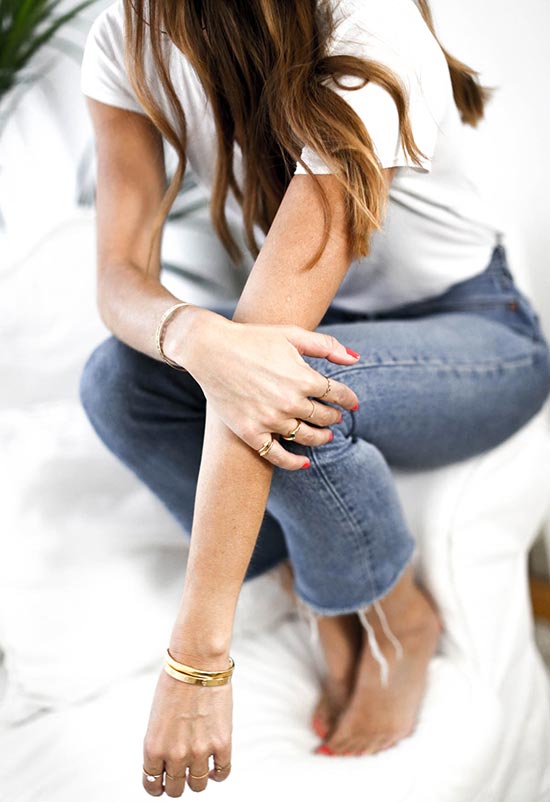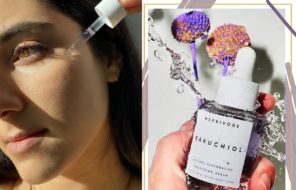Even if you’re diligent about taking care of your feet, getting dry skin can be somewhat inevitable. Maybe you’ve been wearing sandals several days in a row, and your feet are getting a bit dry. Or, more commonly, it’s the winter season, and you haven’t kept up with your daily foot exfoliation routine since no one sees your tootsies anyway.
Regardless of the reason, you don’t have to suffer from feet that have seen better days. Understanding what causes dry or cracked heels and feet, as well as the best practices and cracked heel remedies that you can use, can ensure that your feet always look their best.
In this article:
Symptoms
The most obvious symptom associated with cracked heels or dry feet is having dry, flaky skin on the heels, throughout the soles, your toes, and even the upper portion of your feet. And, according to the National Foot Health Assessment that was conducted in 2012, as many as 20% of American adults suffer from the condition with women being 50% more likely to report having it than men.
In most cases, cracked heels and dry feet are more of a cosmetic issue, as the cracks aren’t very deep. But for some individuals, the condition can be much worse. In particular, some people may experience:
- Itching
- Flaky skin
- Bleeding
- Ulcerations
- Inflamed skin
- Pain
For most people, cracked heels are simply an unsightly temporary condition. But left untreated, cracked heels can become serious problems. In severe cases, you can even lose feeling in your heels, develop an infection, or encourage a diabetic foot ulcer if you have diabetes. If your cracked heels have become painful, or you’re experiencing soreness and redness that lasts for several days, you need to seek treatment immediately.
Cracked Heels Causes
Dry feet and cracked heels have a variety of causes, but there are a few scenarios that tend to be common themes behind this avoidable condition.
Lack of Moisture
Some people tend to forget that their feet need to be moisturized regularly, just like the rest of their bodies. Considering how much you use your feet, leaving them dry for extended periods can encourage calluses to develop, which can encourage not just dry feet but also cracked heels.
Similarly, taking overly long, steamy hot showers or baths can also sap your skin of essential moisture. So, after bathing, you should immediately follow up with a body moisturizer – either a lotion, body oil, or cream – to help protect your skin’s natural moisture barrier and prevent excessive dryness. Also, note that living in some regions that are known to be especially dry can also contribute to dry feet and cracked heels.

Overuse and Misuse
The most obvious reason is that your feet can naturally develop calluses when you walk or stand for extended periods. Over time, the skin on the soles of your feet gets thicker and harder, which is what causes calluses. As you continue to walk, those calluses can crack from overuse.
Likewise, wearing ill-fitting shoes is a great way to encourage not just calluses but also corns, bunions, and a host of other foot conditions. You should ensure that you’re buying shoes that fit your feet properly and avoid wearing shoes with open backs or high heels often, as this can also contribute to dry and cracked heels.
The Diabetes Link
While the link isn’t fully understood, there’s a direct connection between being diagnosed with diabetes and slow wound healing. But specifically, people with diabetes that isn’t well managed – known as uncontrolled blood sugar – are at a higher risk of also developing nerve damage in peripheral parts of their body. This is especially likely to occur on their feet.
Another common side effect of uncontrolled blood sugar is poor circulation, which can encourage dry skin. As a result, they may not experience the irritation or discomfort in their feet that would alert them to a problem like someone without diabetes.
Other Known Causes
Sometimes temporary conditions can also contribute to dry feet or cracked heels. In particular, obesity, pregnancy, aging, and even developing a vitamin deficiency, atopic dermatitis, or fungal infection can all increase a person’s risk of experiencing skin problems on their feet.
Cracked Heels Remedies
Like we mentioned earlier, for most people, seriously dry feet or cracked heels are nothing more than a temporary although embarrassing condition. In most cases, unsightly feet can be reversed by prioritizing keeping your feet moisturized and engaging in routine exfoliation with particular attention to your heels.
The following at-home dry feet remedies have been proven to work. However, if you have diabetes and are experiencing foot problems, speak to a podiatrist or dermatologist before you attempt a DIY foot treatment to get rid of calluses or cracked heels.
Exfoliate
First things first, you need to slough off the dead, dry skin that’s making your feet look like they’ve seen better days. With the exfoliation step, you have a few options. You can engage in manual exfoliation by using a pumice stone or foot file, use an exfoliating foot peel, or a combination of the two.
If you opt for a pumice stone or file to manually exfoliate, incorporate that step after you’ve bathed so that your skin is softer and it’s easier to manipulate. Avoid using razors or scissors to shave or cut off callused skin, as it’s possible to accidentally cause more damage. This is especially true for diabetics, as there’s a risk of slow wound healing. For best results, use your pumice or file daily.
Similarly, an exfoliating cream formally known as a keratolytic can help to actively soften your skin without you having to do the heavy lifting. These topical treatments tend to be heavier so that they penetrate tough layers of skin. Typically, these types of creams contain active ingredients such as alpha-hydroxy acids (AHAs), salicylic acid, or urea. Note that two common AHAs found in exfoliating foot creams are lactic acid and glycolic acid.
After cleansing your feet, you can simply apply the exfoliating cream and let the cream do the heavy lifting. Additionally, you can use manual and topical exfoliation techniques together if your feet are in especially bad shape. Start by manually exfoliating with a pumice or file and then follow up with a topical cream.
For best results, invest in a good pair of moisturizing socks. Using regular socks can create inconsistent results, as the sock material can absorb the cream and delay treatment.

Layer Your Moisturizers
The best way to prevent developing cracked heels or dry skin is to keep your feet moisturized. But if you’ve already got dry skin, moisturizing is the key to getting back to having pretty feet.
Invest in moisture-rich foot creams, like lotions, salves, and creams. But depending on the severity of your dry skin, you may want to layer moisturizers by adding in a heavier topical treatment that can actively penetrate beyond the top layer of your skin, known as the epidermis.
Prioritize moisturizers that contain humectants and emollients, powerful ingredients that help your skin retain moisture and stay hydrated. Ceramides are a popular emollient choice, and they work to help minimize water loss and fill in spaces between skin flakes to restore your skin’s natural barrier. But sometimes, this might not be enough – especially if you live in a drier region.
Opt for a thicker moisturizer, known as an occlusive as a secondary layer of protection after your first moisturizer has properly dried. Popular options include petroleum jelly, lanolin, and mineral oil. On their own, they’re not always considered ideal moisturizers, as they simply create a barrier layer that prevents moisture loss rather than infusing moisture. But they can serve as a powerful secondary layer after applying a truly effective topical moisturizer.
Drink More Water
As with many health conditions, upping your water intake can help to improve your feet from the inside out. According to experts, your skin can naturally lose around a liter of water a day. And that figure can increase if you live in drier climates. Along with a moisturizing routine, drinking more water can help to ensure that your feet are less prone to dryness over time.
Cover and Protect Heel Cracks
If you have serious heel cracks, you want to avoid developing an infection. For more severe cases, use a liquid bandage to aid in protecting and covering cracked skin. However, if you have more intensive heel cracks, your best bet is to speak with a podiatrist or dermatologist for more targeted treatment solutions.
Prevention
While preventing dry skin isn’t always feasible, cracked heels don’t have to be a de facto part of your life. And more often than not, human behavior is a bigger predictor of developing cracked heels than anything else.
Invest in Proper Footwear
The biggest tip for preventing cracked heels is to wear the proper footwear. In particular, you need to minimize the time spent in open-back shoes, as these often don’t provide proper support and also leave your heels exposed. Over time, you may experience more dryness and pressure, which can lead to cracked heels.
Likewise, stiletto heels shouldn’t be your go-to shoe for everyday wear. Because of how this shoe is designed, it can cause your heel to expand, creating awkward pressure points that can encourage the development of calluses, which can lead to cracked heels.

Try to Minimize Standing Time
This is a tip that might not be feasible for everyone, depending on your workplace setting. But if you can, try to avoid standing in one position for too long. Similarly, experts encourage people with cracked heels to avoid sitting in one position for too long or sitting with their legs crossed for extended periods.
Incorporate Orthotics
Poor posture and uncomfortable pressure points on your feet can also encourage the development of heel cracks. Consider having custom shoe inserts made for you. These will help to create better weight distribution for your feet.
Moisturize Regularly
Believe it or not, your feet have skin too. And like the rest of your body, you need to keep your feet properly moisturized. Be sure to apply a moisturizer twice a day, opting for a thicker foot cream at night. If you prefer, get a pair of moisturizing socks to help lock in moisture. And during the day, consider incorporating a silicon heel cup to prevent your heel pad from drying out or expanding.
Be Proactive If You Have Diabetes
Dry feet or cracked heels can be more than a minor annoyance for people with diabetes. Especially if your blood sugar isn’t well managed, you need to check your feet regularly for signs of damage. Dry feet and calluses can easily turn into something more serious if left untreated. When in doubt, speak with your physician, a podiatrist, or dermatologist if you have diabetes and are concerned about your feet.
Photos via @bartabacmode, Instagram





